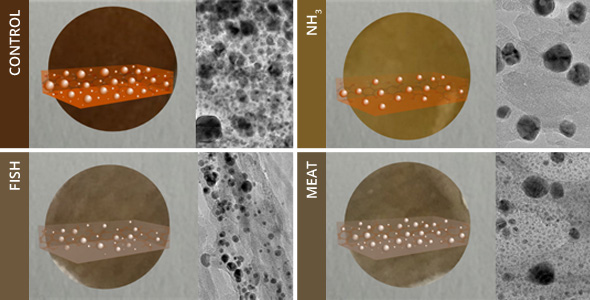ICN2 researchers from Nanobioelectronics and Bisoensors Group, led by ICREA Professor Arben Merkoçi in collaboration with researchers in Canada and Iran, report a novel sensing technology for the visual detection of volatile compounds in a piece of plasmonic nanopaper. Their results have been just published in Nanoscale.

Detection of volatile compounds is often associated with environmental pollution, hazardous chemicals and potential biomarkers. For this reason the development of novel detection technologies for such compounds is a paramount research field and related technologies remain under development. The emerging approaches intended for volatile compound sensing are expected to be simple, safe, low-power, stable, inexpensive and easy-to-use. In this context nanomaterials properties in general and particularly localized surface plasmon resonance exhibited by noble metal nanoparticles (NPs) can be sensitively tuned by varying their size and interparticle distances.
Noble metal NPs are stable, easy to synthesize and endowed with a relatively endless amount of photons for sensing applications over long time periods, which can even be visually detected. Given these extraordinary behaviours, nanosensing technology is capitalizing on analyte–nanoparticle interactions that modulate the size, shape, composition, and interparticle distance of the NPs, the dielectric properties or the refractive index of the surrounding medium to engineer advantageous nanoplasmonic sensing systems.
A recent research published in Nanoscale demonstrates a simple-to-use plasmonic nanopaper designed as a hybrid material based on silver nanoparticles embedded in bacterial cellulose that is amenable to the detection of analytes in the gas phase with no extra reagents. It is discovered that corrosive vapour (ammonia) exposure dramatically reduces the population density or size distribution of silver nanoparticles (AgNPs) embedded within the studied nanoplasmonic membrane, leading to a modulation of the UV-Vis absorbance corresponding to the explored nanoplasmonic properties, which can even be determined visually.
The discovered phenomena is proposed as a simple visual detection technology of volatile compounds in a flexible, transparent, permeable and stable single-use nanoplasmonic membrane, which opens the way to innovative approaches and capabilities in gas sensing and smart packaging.
This work was carried out by Bentolhoda Heli (visiting PhD student from Polytechnique Montréal in Canada supervised by Prof. Abdellah Ajji) and Dr. Eden Morales-Narváez and headed by ICREA Research Prof. Arben Merkoçi in collaboration with Dr. Hamed Golmohammadi, from ACECR Production Technology Research Institute in Iran.
Article reference:
B. Heli, E. Morales-Narváez, H. Golmohammadi, A. Ajji, A. Merkoçi. Modulation of population density and size of silver nanoparticles embedded in bacterial cellulose via ammonia exposure: visual detection of volatile compounds in a piece of plasmonic nanopaper. Nanoscale, 2016; DOI: 10.1039/c6nr00537c
http://pubs.rsc.org/en/content/articlepdf/2016/nr/c6nr00537c?page=search

